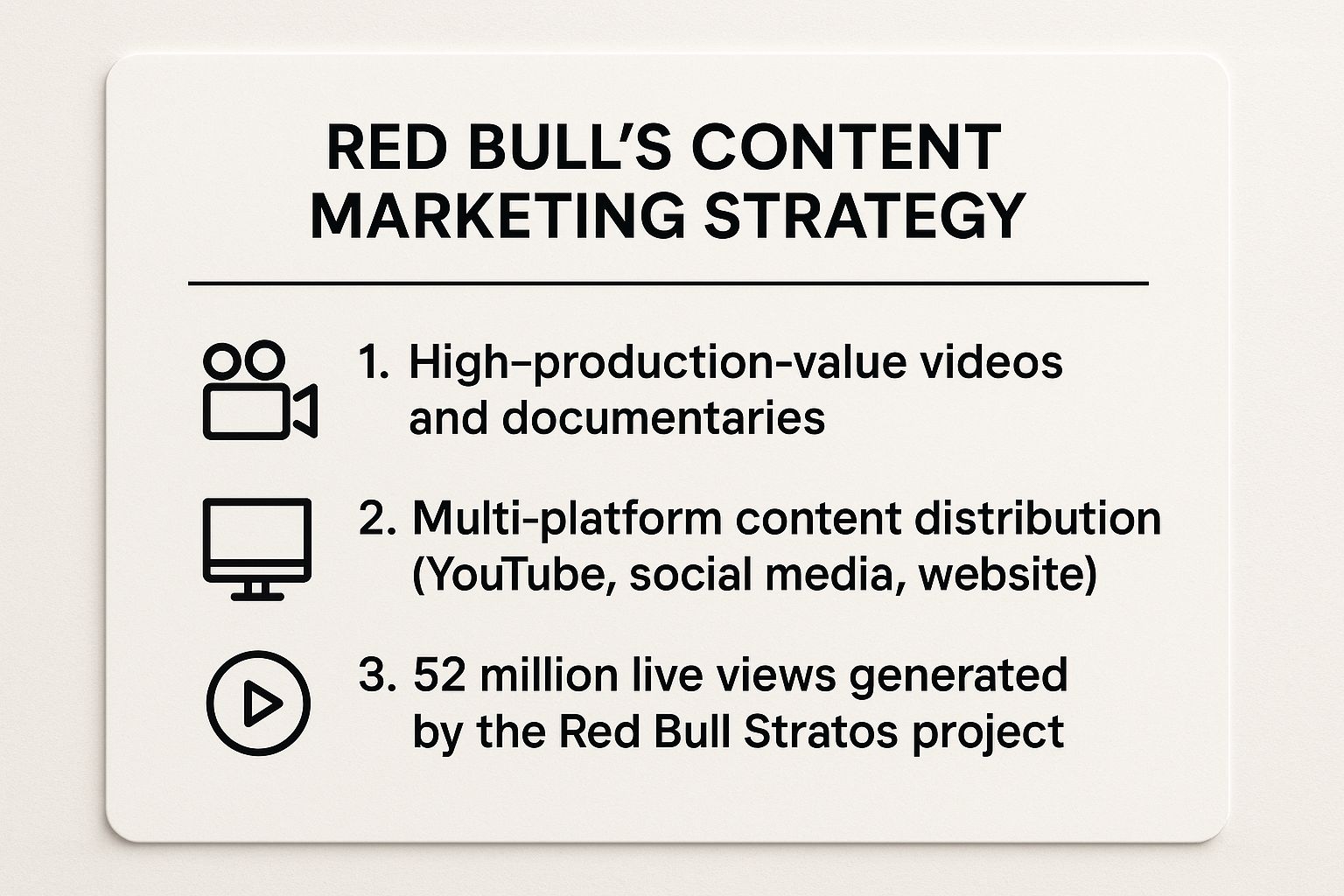
Struggling to create a content marketing strategy that actually connects with your audience and drives results? It's a common challenge for digital agencies and marketers. You see brands succeeding, but the "how" behind their success often remains a mystery, leaving you with more questions than actionable plans. You need concrete content marketing strategy examples, not just high-level theory, to understand what truly works. This article cuts through that noise.
We’ll dissect seven brilliant content marketing strategies from iconic brands like Red Bull, HubSpot, and Airbnb. We'll break down their core approach, analyze their tactics, and extract key insights you can apply directly to your own work. You won't just see what they did; you'll understand why it worked and how to adapt their methods for your brand. Get ready to transform your approach by learning from the best in the business.
👉 Try MediaWorkbench.ai for free – schedule your posts and generate AI content in one place!
1. Red Bull: The Extreme Sports Content Empire
Red Bull transformed content marketing from a promotional tool into a media empire. Instead of creating content about their energy drink, they built a universe of content around the lifestyle their brand represents: energy, adventure, and pushing human limits. This is a powerful content marketing strategy example because it shows how a brand can become a publisher, owning a niche so completely that it becomes synonymous with it. By focusing on the audience's passion for extreme sports, Red Bull builds a deep, emotional connection that traditional advertising cannot match.
Strategic Analysis
Red Bull’s strategy is built on a simple yet profound principle: create content so compelling that people would seek it out, then give it away for free to build brand affinity.
- Focus on Brand Ethos, Not Product: Their content rarely features the product directly. Instead, it embodies the brand's core values. The legendary Red Bull Stratos project, which saw Felix Baumgartner jump from the stratosphere, was the ultimate expression of this. It wasn't an ad; it was a story about breaking barriers.
- Invest in High-Quality Production: By investing heavily in production, they create cinematic experiences that rival major sports broadcasters, elevating their brand perception.
- Create Events as Content Hubs: Events like the Red Bull Flugtag are massive content generation opportunities, creating live streams, highlight reels, and social media updates.

Actionable Takeaways
- Identify Your Brand's "Why": What does your brand stand for beyond its products? Define the lifestyle or values that resonate with your audience.
- Become a Niche Publisher: Own a topic. Instead of talking about your software, create the best resource for project management productivity hacks.
- Prioritize Quality Over Quantity: One well-produced video or case study can have more impact than 100 low-effort blog posts.
- Think Like an Entertainment Company: Create stories with heroes (your customers), conflict, and resolution.
2. HubSpot: The Educational Inbound Machine
HubSpot didn't just popularize inbound marketing; they built their entire empire on it. Instead of aggressively selling their software, they focused on solving their audience's core problems through high-value, actionable content. This is a premier B2B content marketing strategy example because it demonstrates how to build trust and authority by teaching, not just telling. By offering comprehensive resources like their blog, academy, and free tools, HubSpot positions itself as an indispensable partner in a business's growth journey. This educational approach generates goodwill and naturally guides users toward their premium products.
Strategic Analysis
HubSpot's strategy is to be so helpful that their target audience can't ignore them. They trade expertise for attention, building a massive lead generation engine fueled by free, high-quality educational content.
- Solve Problems with Comprehensive Content: The HubSpot Blog receives over 4.5 million monthly visitors by providing expert answers to virtually any marketing or sales question.
- Educate and Certify Your Audience: The HubSpot Academy teaches valuable skills and familiarizes professionals with HubSpot's tools, creating a highly qualified user base.
- Demonstrate Value with "Freemium" Tools: HubSpot offers free versions of its CRM and marketing tools. This removes the barrier to entry, allowing businesses to experience the product's value firsthand.
Actionable Takeaways
- Identify Your Audience's Biggest Pains: What are the most common questions your customers face? Build your content strategy around providing the best solutions.
- Give Away Your Best "Secrets": Create detailed guides and tutorials that empower your audience. Your generosity will build trust and establish you as the go-to expert.
- Use Content to Nurture Leads: Map your content to different stages of the sales funnel. An introductory blog post might attract a new visitor, while a webinar can convert them into a lead.
- Leverage Technology to Scale: Exploring how to use AI for marketing can help streamline processes, from generating ideas to analyzing performance.
3. Dove: The Mission-Driven Storyteller
Dove shifted the conversation in the beauty industry by focusing on a mission-driven content strategy. Instead of creating content about their soaps, they built a powerful narrative around "Real Beauty," championing self-esteem and body positivity. This is a classic example of a content marketing strategy that aligns a brand with a significant social issue, creating deep emotional resonance. Dove uses authentic storytelling, often featuring real women instead of models, to challenge stereotypes. This approach turns customers into brand evangelists who share the content because they believe in its message.

Strategic Analysis
Dove’s strategy is built on transforming a brand into a social cause. By addressing a genuine pain point for its audience, the brand fosters loyalty that transcends product features.
- Focus on a Core Brand Mission: The entire campaign is anchored to a single, powerful idea. The viral "Real Beauty Sketches" video, with over 200 million views, perfectly executed this by showing how women perceive themselves versus how others see them.
- Create Emotionally Viral Content: Dove masters creating content that is highly shareable because it evokes strong emotions like empathy and inspiration.
- Invest in Long-Term Educational Initiatives: The Dove Self-Esteem Project provides accredited educational resources for parents and teachers, demonstrating a genuine commitment to the cause.
Actionable Takeaways
- Define Your Brand's Authentic Mission: What social or emotional issue genuinely matters to your brand and your audience? Build your content around that value.
- Use Authentic Storytelling: Feature real customers or employees. Their genuine stories will resonate far more deeply than polished corporate messaging.
- Create Content That Starts a Conversation: Don't just broadcast messages. Ask questions and create campaigns that encourage your audience to share their own experiences.
- Go Beyond Marketing: If you champion a cause, prove your commitment. Develop resources or partner with non-profits to show you are invested in making a real difference.
4. Airbnb: The Community-Powered Content Platform
Airbnb’s brilliance lies in shifting the focus from transactions to transformations. Instead of marketing rooms, they market experiences and belonging. Their content marketing strategy is powered by their users: the hosts and guests. By prioritizing authentic, user-generated content (UGC), Airbnb builds a community-driven brand narrative that feels genuine and compelling. This is one of the most effective content marketing strategy examples for building trust and scale. Their approach turns every trip into a potential story, providing a massive, low-cost pipeline of content and powerful social proof.
Strategic Analysis
Airbnb’s strategy is to facilitate and amplify storytelling, making their community the hero. They built a system that encourages, curates, and celebrates user-generated content.
- Empower the Community to Be Storytellers: Airbnb actively encourages storytelling. Campaigns like #AirbnbExperience prompt users to share unique moments, making them feel like valued contributors.
- Curate UGC into High-Quality Brand Assets: The best user content is elevated into official brand assets, such as in the former Airbnb Magazine, which blurred the line between user content and premium editorial.
- Provide Tools that Naturally Generate Content: Features like City Guidebooks created by local hosts provide genuine value to travelers while simultaneously creating unique, shareable content.
Actionable Takeaways
- Create a Stage for Your Customers: Actively create spaces for your customers to share their stories, like a dedicated hashtag or a "story of the month" feature.
- Incentivize High-Quality Submissions: Run contests or offer perks for the best photos, videos, or testimonials to encourage high-effort content.
- Repurpose UGC with Credit: Showcase the best user content on your website and social media. Always give proper credit to the original creator.
- Turn Customers into Experts: Empower your super-users to create tutorials or guides. This builds a library of authentic content while validating their expertise.
5. Buffer: The Radically Transparent Brand
Buffer flipped the traditional corporate playbook on its head by building a brand on radical transparency. Instead of broadcasting marketing messages, Buffer chose to share everything: its revenue, employee salaries, and even its mistakes. This approach is a masterclass in building trust and authority, transforming a simple software company into a beloved thought leader. This transparency isn't a gimmick; it’s woven into every aspect of their content. This strategy attracts customers who share their values and positions them as an authentic, human-centric brand.
Strategic Analysis
Buffer's strategy is to use transparency as its primary content driver, creating a powerful inbound marketing engine fueled by trust.
- Make Business Operations the Content: Buffer’s most powerful content assets are internal documents. Their Open Revenue Dashboard and public salary formulas turn potentially dry business data into fascinating, educational content.
- Share Both Wins and Losses: Buffer openly blogs about challenges and failed experiments. This vulnerability makes their successes more credible and builds a resilient brand that customers want to support.
- Educate Through Openness: The Buffer Blog provides immense value with social media tips, but its most unique content details Buffer's own experiments. For those seeking deeper insights, resources about social media automation software can provide further context.
Actionable Takeaways
- Start Small with "Selective Transparency": Begin by sharing the "how" behind a successful project, including the challenges and lessons learned.
- Document, Don't Just Create: Turn your internal processes into content. Share your team's productivity workflow or your content creation checklist.
- Embrace Vulnerability: Share a story about a mistake or a project that didn't go as planned. This humanizes your brand and builds trust.
- Align Content with Company Values: Ensure your transparent content reflects your core company values. If a value is "learning," share what your team is learning publicly.
6. Nike: The Inspirational Storyteller
Nike’s marketing transcends selling apparel; it sells an idea. The core of their content strategy is built on inspirational athlete storytelling, transforming their brand into a symbol of motivation and human potential. Instead of focusing on product features, Nike crafts powerful narratives around the struggle and triumph of athletes, from global icons to everyday heroes. This approach makes their content emotionally resonant and universally relatable. Their success perfectly illustrates the immense power of storytelling in marketing to build deep emotional connections.
Strategic Analysis
Nike's strategy revolves around a single, powerful concept: celebrate the athlete, and the product will follow. They make the hero of their story the individual, not the shoe.
- Focus on Human Triumph Over Adversity: The Colin Kaepernick "Dream Crazy" campaign is a prime example. It centered on the athlete's story of sacrifice, connecting the brand to a powerful social cause.
- Create Content that Motivates Action: The Nike Training Club app is a brilliant content marketing ecosystem. It serves, not just sells, by providing free workout plans and wellness tips, building daily brand engagement.
- Turn Sporting Events into Legendary Sagas: Nike's Breaking2 project, which documented the attempt to run a sub-two-hour marathon, was a masterclass in content creation that celebrated human limits.
Actionable Takeaways
- Find the "Why" in Your Customer's Story: Your customers are the heroes. Create case studies that focus on their personal or professional triumphs.
- Align with a Mission: What does your brand stand for beyond profits? Connect your content to a value or a cause that resonates with your audience.
- Create Content that Helps, Not Just Sells: How can you empower your audience? Offer valuable tools or guides that help them achieve their goals.
- Embrace Emotional Narratives: Logic sells features, but emotion builds brands. Craft stories that tap into universal feelings of struggle, ambition, and success.
7. GoPro: The UGC Adventure Platform
GoPro mastered a content marketing strategy that turns its customers into its most effective marketers. Instead of relying solely on in-house production, GoPro built a brand fueled by authentic, thrilling content created by people using their products. This approach is one of the best content marketing strategy examples because it transforms a product into a platform for community and storytelling. The company created a self-sustaining content ecosystem: showcasing incredible user videos inspires a global community to capture and share their own adventures, generating an endless stream of high-impact marketing assets.
Strategic Analysis
GoPro’s strategy empowers and incentivizes its user base to become brand ambassadors. They created a flywheel effect: great user content inspires more people to buy cameras, which generates even more content.
- Make Customers the Heroes: The GoPro Awards program offers cash prizes for the best photos and videos, turning a hobby into a potential gig and making creators feel valued.
- Curate and Amplify at Scale: GoPro’s YouTube channel acts as the ultimate highlight reel for its community, giving creators massive exposure while building a content library that sells the dream.
- Guide Submissions with Themed Challenges: Campaigns like the annual GoPro Million Dollar Challenge invite users to submit their best clips from a new camera, creating urgency and providing a trove of promotional material.
Actionable Takeaways
- Incentivize Creation: Create a clear reason for users to share, such as a contest, a monetary reward, or a feature on your social media page.
- Make Sharing Effortless: Establish a simple submission process using a branded hashtag (like #GoPro) or a dedicated upload portal.
- Build a Content Curation Engine: Don't just collect content; showcase it. Feature the best UGC prominently on your website and social channels.
- Set Creative Guardrails: Launch themed contests or provide creative prompts to guide submissions and ensure the UGC aligns with your brand messaging.
Your Turn: Build a Winning Content Strategy
The powerful content marketing strategy examples we've explored prove that success isn't about having the biggest budget. It’s about a relentless commitment to providing genuine value to a specific audience. Whether it's HubSpot empowering marketers with education, Airbnb celebrating community-driven stories, or Nike inspiring millions through powerful narratives, the core principles remain the same. These brands built ecosystems of trust, entertainment, and utility by understanding their audience's needs and aspirations.
Remember these fundamental takeaways as you move from inspiration to implementation:
- Audience-Centricity is Non-Negotiable: GoPro and Airbnb didn't just create content for their users; they built platforms that allowed users to become the creators.
- Authenticity Over Everything: Buffer’s radical transparency built a level of trust that traditional advertising can't buy. Your brand's unique values are your greatest assets.
- Consistency Creates Momentum: HubSpot didn't become a marketing authority overnight. Their success was the result of years of consistently publishing high-quality, helpful content.
Ready to turn your strategic vision into reality? MediaWorkbench.ai provides the tools you need to streamline your entire content workflow, from AI-powered idea generation and creation to automated scheduling and publishing. Stop juggling multiple platforms and start building your content engine efficiently.
👉 Try MediaWorkbench.ai for free – schedule your posts and generate AI content in one place!

